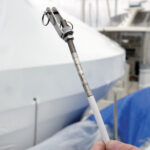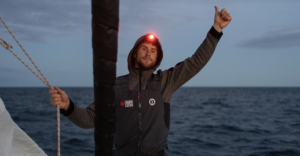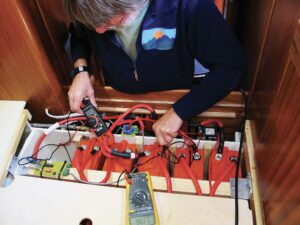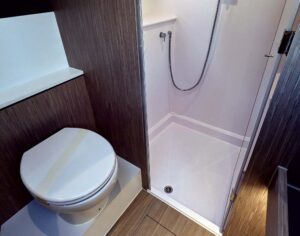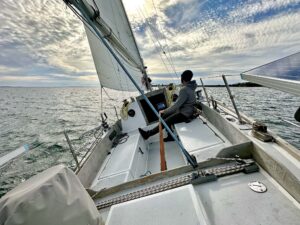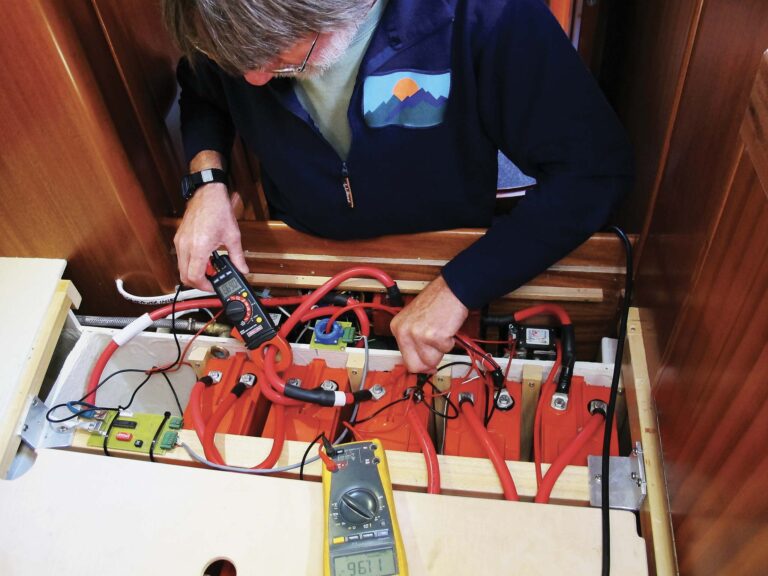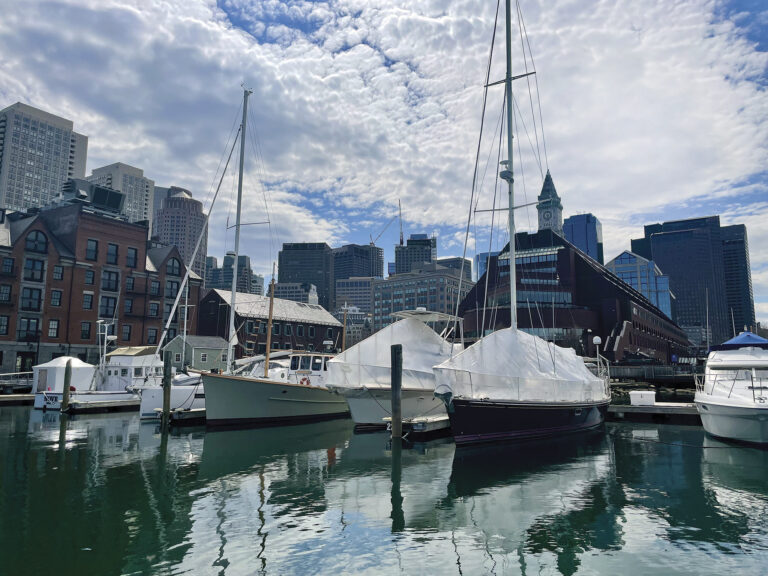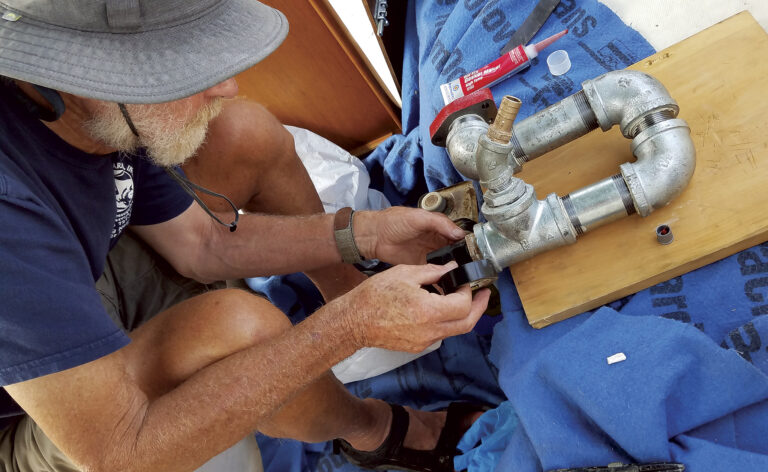
As with so many other things on our 1987 Pearson 39-2 project boat, the lifelines looked to be original equipment. Made of vinyl-coated 3/16in 7×7 stainless steel wire, they were bleeding rust where the sheathing had cracked, and it was obvious they needed to be replaced. The only question was, with what?
For years sailors only had to choose between coated and uncoated wire for lifelines. Now, the increasing uses on board of the low-stretch, super-strong fiber Dyneema have spread to the humble lifeline. I’d replaced the rusted-out lifelines on our previous boat with coated wire, but now I wasn’t sure which way to go. I began by summarizing the pros and cons of each approach.
Coated stainless steel wire
Pros: looks good, comfortable to hold, low chafe potential where sheets or other lines come into contact, long lifespan. Cons: More fiddly to work with, eventually the vinyl coating hardens and cracks, corrosion spreads inside the sheath and can be impossible to detect before it’s too late. Needs swaged or crimped end fittings so can be finicky to DIY.
Uncoated 1 x 19 stainless steel wire
Pros: Attractive shiny finish, easy to inspect for corrosion, long lifespan, slightly less windage—important for racers! Cons: rougher on hands and clothing, needs swaged or crimped end fittings so not ideal for DIY.
High-tech rope
Pros: Greater strength for its diameter than wire, easy to splice, lightweight, feels good to the touch, easy to inspect, needs fewer fittings than wire. Cons: More susceptible to chafe and UV degradation so will need to be replaced more often.

The process
As a boat owner you have two options for renewing wire lifelines: source and purchase the wire and fittings and install them yourself, or measure the existing ones and send the details to a rigger or rigging service and have them made professionally. (There is a useful lifeline measurement guide at csjohnson.com.) Or, since correct measurements are critical, you can just take the old ones to the rigging shop to be duplicated.

A professional will swage the end fittings on; the do-it-yourselfer will use crimp terminals from C.S. Johnson or swageless connectors from Suncor. We used C.S. Johnson’s hand-crimp fittings when replacing the coated wire lifelines on our Norlin 34. It was not a difficult job, but it was fiddly and time-consuming and would have been even more so had I not been able to borrow an expensive lever-type tool that made short work of the actual crimps. Otherwise, I would have had to use their bolt-type crimper, which would have taken significantly longer. It started as a fun project, but before I was a quarter of the way through I was kicking myself for having chosen coated wire, as it was a real nuisance to trim the coating off the ends that were to be inserted into the studs. Each fitting required three crimps staggered around the circumference of the stud and since there were 24 terminations in total, you can imagine the fun I had.
Whether you decide to take on the wire lifeline renewal yourself or have a rigger do it, you should be able to re-use your existing turnbuckles or pelican hooks and just replace the studs, which will mitigate the expense. Note, though, that modern pelican hooks are much easier to use than older styles so it may be worth upgrading these, at least.
As for the cost of wire, it varies, so shop around. On the West Marine website, I found uncoated 3/16in 1×19 wire going for $1.99/ft and coated 7×7 of the same size at $1.79/ft.
I have seen some debate on the strength of hand-crimped versus swaged lifeline fittings. All I can say is that when my propeller picked up a spinnaker guy that was tied to a 3/16in coated lifeline, said lifeline, with crimped terminals showed no sign of stress.
High Fiber
Ultra-High Molecular Weight Polyethylene, or HMPE, popularly known as Dyneema or Spectra, is some 15 times stronger than steel weight-for-weight; 5mm (3/16)Amsteel Blue has a tensile strength of 5,400lb. It’s also versatile, chafe-resistant, easy to splice and more resistant to UV degradation than many other fibers. Among its many other uses on board, it has become popular for lifeline replacement.
The choice facing you will be to use single braid or double braid Dyneema. Single braid is easier to splice and unambiguous in its sizing—5mm single braid (the maximum thickness needed for lifelines) will be just that, whereas a 5mm double braid will actually have a 4mm core and thus be considerably weaker. Single braid looks utilitarian whereas double braid has a slicker, more professional appearance, though the double-braid cover serves purely to protect the core and carries no load. It will, however, provide extra resistance to UV degradation and chafe. Double braid is also more difficult to splice than single braid—unless the cover is cut back to expose the core—so the DIY sailor will more than likely opt for single braid, as I did.
As for thickness, you could get away with 3mm or 4mm line on smaller boats, but 5mm is stronger and has a better feel to it. All of the major rope makers will have their own version of single braid Dyneema—Samson’s is called Amsteel Blue; New England Ropes has HT-75; FSE Robline’s is Ocean 3000. I shopped around online and eventually bought a 200ft length of 5mm gray Amsteel for $160. The combined length of all my lifelines was under 160ft, but I wanted to allow an extra foot of line for each of the 24 splices that would be required—along with a fudge factor should I get a measurement wrong.
You can make up the lifelines by passing the Dyneema though the stanchions, splicing in an eye with a thimble at each end and lashing these to the pulpit or sternrail eyes with Dyneema cord. That’s the simplest way of doing it, if you don’t have lifeline gates. Alternatively, C.S. Johnson makes a range of handsome brushed stainless fittings specially for HMPE line. Whichever method you use, it’s imperative to splice the line correctly. Instructions for the two commonly used splices for HMPE—the locked Brummel and the easier-to-make Bury—including video tutorials, are available online. HMPE line is extremely slippery, so the splice tail should be at least 63 times the diameter of the line—that’s just over a foot for 5mm line. Note that the Bury splice may come undone unless you whip or stitch it just below the eye. It’s also essential to taper the tail along its length before you bury it.
I like to take the path of least resistance when it comes to boat projects—well, whenever possible—so I cheated and made use of a Barton Easysplice fid that I’d had on board for a year or so awaiting just such a project. It’s intended specifically to splice HMPE line, and with its help I made the initial Brummel splices in double-quick time—it took less than an hour to measure, cut, splice and install the top lifelines. One lesson I soon learned was that if you are using metal fittings like turnbuckles or pelican hooks, you need to extend the adjuster threads to their maximum, for there is inevitably some creep in the Dyneema. I had to remake two splices for this reason after bottoming out on the threads. If I’d been smarter, I would have pre-stretched the lines. If you’ve gone the eye-splice-and-lashing route, you should have more leeway to tension the line.
Among other things to look out for are sharp edges on stanchions; inspect them carefully and file away any burrs or other defects that might cut fibers. If sheets bear on the lines on any point of sail, that’s another possible chafe point. Even so, Dyneema is remarkably chafe-resistant compared to most other fibers used for ropes, and if you check your lifelines regularly any hint of damage will be plain to see. Should a lifeline be somehow severed, I also have enough spare Dyneema on board to make up another one in next to no time.
I’m happy with my new lifelines; they look good, provide excellent grip and were easy and cost-effective to install. As for lifespan, numbers from three to seven years are regularly bandied about. If I can split the difference and replace all my lifelines for under $200 in five years, I’ll have no complaints at all.
Resources
Barton Marine bartonmarine.com
Colligo Marine colligomarine.com
C. S. Johnson csjohnson.com
FSE Robline roblineropes.com
Hayn Marine hayn.com
Marlow Ropes marlowropes.com
New England Ropes neropes.com
Samson Ropes samsonrope.com
Suncor suncorstainless.com
West Marine westmarine.com
Yale Cordage yalecordage.com
April 2019

